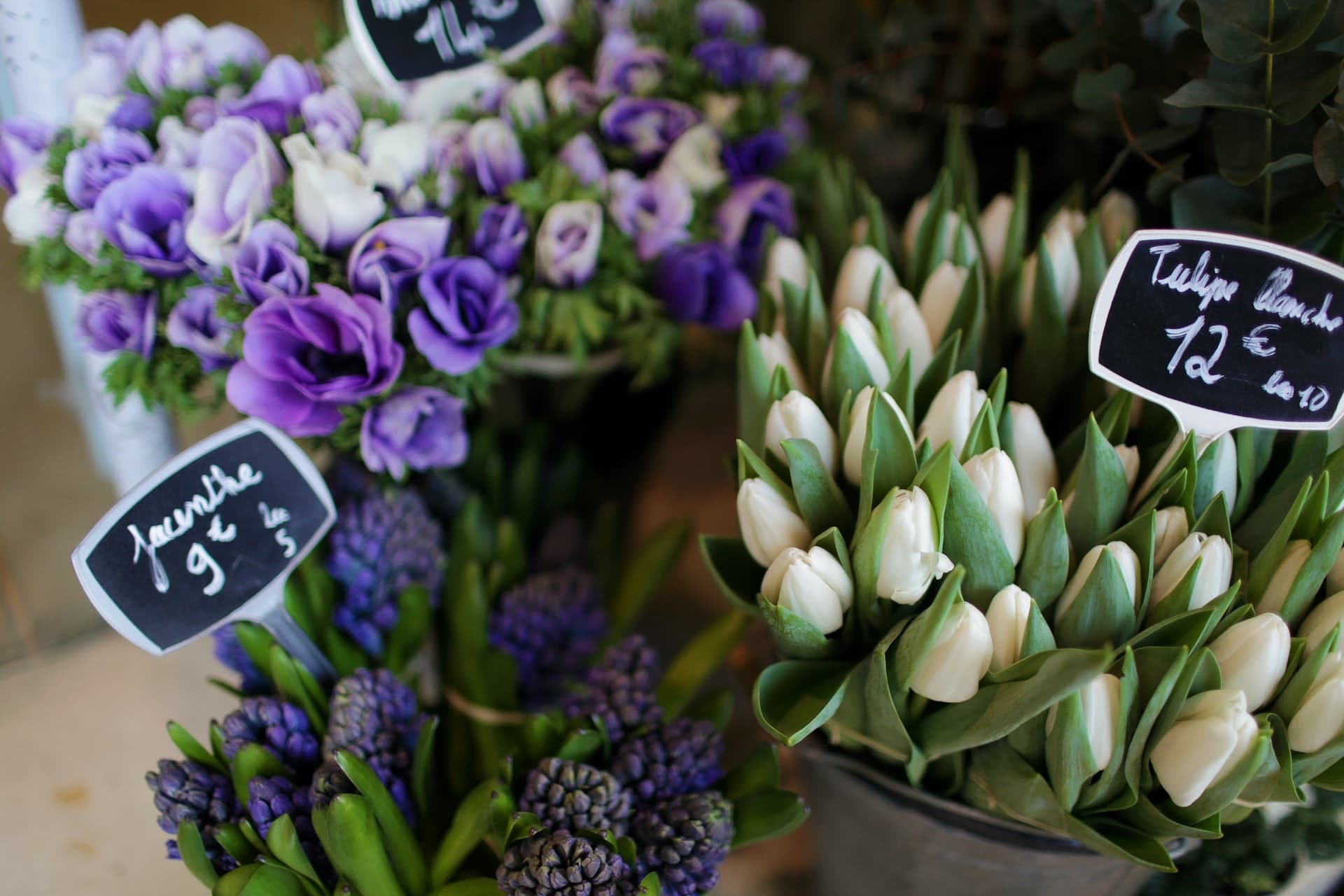With Valentine’s around the corner, flowers tend to be one of the top gifting picks, which is why we put together these stats.
Here we’ll tell you all about the lead flower-producing countries in the world, which flowers are popular in different places round the world, the number of people involved in the industry, and so on.
If these questions have tickled your curiosity, just keep scrolling!
Top 10 Floral Industry Statistics
- The online floral industry in the US is worth around $5 billion.
- Europe produces primarily ornamental flowers.
- The Australian flower retailing industry is worth over $829 million.
- In the US, most flowers are sold on Valentine’s Day and Mother’s Day.
- The value of the UK flower market is worth around $3 billion in sales.
- About 74,787 people work in the US floral industry.
- The biggest roses in the world are produced in Ecuador.
- The global orchid industry is worth $5,152 million.
- In Canada, over $106.3 million was spent on cut flowers in 2020.
- The artificial flower and plant industry in the US will increase by $369.08 million by 2025.
Current Statistics on the Floral Industry in the US
In the first section, you’ll find out which states the US imports most flowers from, which American states are the biggest flower producers, and more.
1. About 74,787 people work in the US floral industry.
(The Florist Guide)
There are 32,370 floral businesses in the country. Though this may sound like a big number, it’s actually in decline. More specifically, the industry growth rate between 2014 and 2019 was an average of -1.8%.
2. Most flowers are sold on Valentine’s Day and Mother’s Day.
(Second Measure, Teleflora)
In 2017, 21% of flower sales were made in the two weeks leading up to Mother’s Day. With some vendors, most sales were made around Valentine’s Day, but Mother’s Day seemed to be in the lead after all.
While cut flowers are more popular around Valentine’s, potted plants win the ‘most popular’ title for Mother’s Day.
3. One of the biggest flower companies is located in the US.
(BizVibe)
Kurt Weiss Greenhouses Inc. is an American company that was among the top ten floriculture companies in 2020. Other countries that made the list were:
- Israel (Danziger Group),
- Switzerland (Syngenta),
- Colombia (Multiflora Ltd.),
- Germany (Selecta Group),
- Uganda (Ruparelia Group),
- the Netherlands (Dümmen Orange and Marginpar BV),
- Kenya (Karen Roses and The Kariki Group).
4. The online floral industry in the US is worth around $5 billion.
(The Florist Guide)
Buying flowers in physical shops is gradually losing popularity because online flower shops have witnessed an 11.8% growth in recent years, as online flower sales statistics indicate.
In addition, people in the US are getting used to ordering flowers online from 230 existing flower businesses online, which have 4,962 employees.
5. The artificial flower market is forecasted to grow in the 2021–2025 period.
(Market Research)
According to certain reports, the artificial flower and plant industry in the US will increase by $369.08 million by 2025. The compound annual growth rate for this period is predicted to be approximately 4%.
Global Floral Industry Trends and Stats
Are you curious about where most flowers are produced and just how much is the global flower market worth? Find out here!
6. The value of the UK flower market is worth around $3 billion in sales.
(Flowers and Plants Association)
This means the average person spends roughly $49 on cut flowers and indoor plants every year. This number was around $11 in 1984, so we can see the amount of money people spend on plants is almost five times what it was about 40 years ago.
7. The global cut flowers market was worth over $34,347 million in 2019.
(Globe Newswire)
As a growing industry, the current floral industry trends project that the worth of this market will reach over $49,000 million by 2028, with a CAGR of 4.04%. The largest share of the market that year belonged to Europe, while segment-wise, roses were in the lead.
8. Europe produces primarily ornamental flowers.
(Medium)
For instance, the Netherlands, Italy, and Germany are responsible for 64% of Europe’s cut flower production. Moreover, data from 2019 shows the continent’s production value amounts to approximately $10 billion.
9. Last year, the Netherlands used 2,726,046 acres for the production of outdoor flower bulbs.
(Statista)
This number steadily rose from 2013, having reached its highest point in 2018—2,755,866 acres. Though it dropped slightly in 2019 and 2020, in 2021, it took an upward turn again.
10. The Netherlands is the number one flower-producing country.
(Medium)
According to 2018 data, the Netherlands produces 52% of the world’s flowers, Columbia comes in second with 15%, and Ecuador is third with 9%. Other countries in the top ten are Kenya, Belgium, Ethiopia, Malaysia, Italy, Germany, and Israel.
11. Cut flower industry statistics show that in Canada, over $106.3 million was spent on cut flowers in 2020.
(Statista)
In the period between 2010 and 2020, Canadians spent the most on cut flowers in 2014 (around $120 million). After that point, the amount of money spent decreased until 2017, when it reached its lowest point—$102.3 million. In 2018, though, the number started growing again.
12. The Australian flower retailing industry is worth over $829 million.
(IBIS World)
The industry includes 2,529 businesses and 5,933 employees in the sector. Moreover, the country doesn’t really have any companies taking the lead in the industry. None of them holds a market share over 5%.
Orchid Industry Statistics
Orchids are popular all over the world. Many people even grow them in pots in their homes. Their beauty, versatility, scent, and use in cosmetics are just part of the reasons.
13. Out of all orchid types, the Phalaenopsis orchid is expected to reach the highest CAGR of 5.6% between 2021 and 2027.
(AllTheResearch)
In 2020, this orchid type was valued at $1,294 million. The Phalaenopsis also holds the largest share of the global orchid market. The flower’s diversity in color and size as well as its long vase life are just two of the reasons that make it so popular.
14. The global orchid industry is worth $5,152 million.
(AllTheResearch)
Flower sales statistics expect the global orchid industry to reach $7,051 million by 2027. The forecasted industry growth also takes into account the noticeable rise in cosmetic brands using orchids in their products.
15. Orchids are primarily used for cosmetics.
(AllTheResearch)
Out of the three ways of application (garden landscaping, cosmetic, and medicine), it seems that cosmetic application leads with a value of $1.6 million in 2020. The orchid flower is used in anti-aging products, different skin creams, and fragrances for cosmetics.
Floriculture Industry Stats by Flower Type
If you want to find out more about where the best roses are produced, the value of tulips, the countries that export the most carnations, and similar pieces of trivia, you’ll love this section.
16. The biggest roses are produced in Ecuador.
(Dose of Roses, Flower Companies)
The biggest and brightest roses are made in Ecuador. In addition, 74% of the flowers that the country exports are roses. Data from 2016 shows approximately 44% of its flower exports are to the USA, 22% to Europe, and 15% to Russia.
17. Tulip bulbs’ high export values make them one of the Netherlands’ trademarks.
(Statista)
In 2008 and 2014, the country’s export value was around $264,900,000. This is the highest value it has reached in the previous 15 years. The lowest point was in 2016, when the export value of the bulbs dropped to $236,100,000.
Interestingly enough, people generally associate the Netherlands with tulips even though they originate from Turkey.
18. On the EU market, Colombia and Turkey are two of the top developing countries that export carnations, according to global cut flower industry statistics.
(CBI)
Other exporting countries include Kenya, Ethiopia, Turkey, and Morocco. On the other hand, the Netherlands accounted for 47% of all EU imports of carnations in 2015. Moreover, Colombia has the most orchid species, but it’s also famous for being the leading developing country that supplies carnations to Europe.
19. The scent that the iris produces is a highly sought-after ingredient.
(BBC)
Cultivating the root of an iris flower is no easy feat, and the scent that can be produced from it makes for a rare and very expensive perfume. Just two pounds of high-quality iris root can go for as much as $50,000 (cca. $56,700). However, the powerful smell means that a few drops are enough per bottle of perfume.
To Sum Up
Floral industry keeps changing, with online shops gaining tons of popularity, especially during the pandemic. We hope these facts about flowers have helped you get an idea of the popular trends, as well as which countries play the biggest roles in the industry on a global level.
FAQ
How many retail florists are there in the United States?
As of 2020, there are over 15,000 retail florists, and the number’s expected to rise between 2020 and 2025.
(Globe Newswire)
How much is the floral industry worth?
The floral industry in the US is worth over $5 billion despite the fact that there was a slight decrease in numbers in the years between 2015 and 2020. Globally, this industry is worth $18 billion.
(IBIS World) (BBC)
What are industry trends in the floral industry?
Flower subscriptions are becoming a big thing in recent years. These subscriptions offer their customers weekly, monthly, and other delivery plans. Also, with the growing focus on environmental impact, more and more people choose their flowers with sustainability in mind.
(Point Franchise)
What is the number of participants in the floral industry?
In the USA, there are 32,370 businesses and 74,787 employees in this industry.
(The Florist Guide)
Is the floral industry dying?
The pandemic has affected everything, and the floriculture industry is no exception. Floral industry statistics show that there’s a serious revenue decline. Some experts predict the industry to get back on track, but it won’t fully recover to its pre-pandemic levels.
(IBIS World)
Sources:
- AGMRC
- AllTheResearch
- BBC
- BBC
- BizVibe
- CBI
- Dose of Roses
- Flowers and Plants Association
- Flower Companies
- Globe Newswire
- Globe Newswire
- IBIS World
- IBIS World
- Market Research
- Medium
- Point Franchise
- Second Measure
- Statista
- Statista
- Statista
- Teleflora
- The Florist Guide
- USAID













